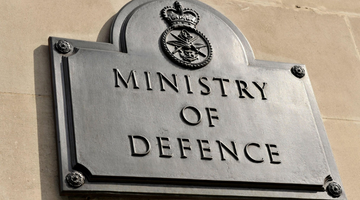
Blog written by Reg Pula, Defence Policy Advisor, ADS
Introduction
Despite the delay in the publication of the new MOD SME Action Plan, industry welcomes the refreshed Plan, which serves as a new and improved update of the previous Action Plan, released in March 2019.
The publication of the Defence and Security Industrial Strategy in March 2021 and the establishment of the SME Working Group in the Defence Suppliers Forum have contributed to strengthening the MOD’s approach to engagement with the SME community as reflected in the new Action Plan.
Industry and the MoD must now further strengthen and develop this strategic partnership in the swift delivery of these commitments to meet the ambitious target for 25% procurement spend on SMEs by the end of this year, maximise the potential of the SME community, and contribute to the Levelling Up agenda.
A new and improved Action Plan
The refreshed MOD SME Action Plan 2022 represents more than just an update to the previous version, released in March 2019. Indeed, the new Action Plan is a strengthened version, both in length and content, which reflects two major developments.
The first is the publication of the Defence and Security Industrial Strategy (DSIS) 2021, which the new Action Plan heavily links to. The DSIS provides the overarching strategic vision for the refreshed Action Plan, the contents of which reflect most of the major themes in the DSIS.
The second is the establishment of the DSF SME Working Group, which ADS and its members are represented at. This group provides SMEs their own voice in the Defence Suppliers Forum (DSF) and provides a clear platform for engagement with the Ministry of Defence on SME issues and delivering the new Action Plan’s commitments. Both developments are much welcomed by industry.
Another clear positive of the new Plan is its structure. Not only does the Plan structurally link in with the DSIS, but it also sets out a list of 13 commitments with deliverables and updated timelines that provides great clarity for industry.
Maximising the potential of the DSIS for SMEs
The 13 commitments in the new Action Plan link in with the DSIS, though providing a particular focus on implications for SMEs, expected outcomes and timelines. These 13 commitments and delivery timelines are presented in the following table:
| Commitment | Outcome | Target Date |
| Commitment #1 Seek evidence from Primes that they have or are developing effective ways of engaging SMEs.
|
Primes focus on strengthening SME engagement and sharing best practice. | By March 2022. |
| Commitment #2 Revise the UK’s Industrial Participation Policy.
|
Encouraging Primes to further consider what the UK supply chain can offer, opening up more opportunities for SMEs. Helping inform HMG what barriers SMEs face. | Q1 2022. |
| Commitment #3 Establish a Defence Supply Chain Development and Innovation Programme. | Support the development of a more productive and competitive UK defence sector domestically and abroad, including the sector’s SMEs, reducing cost and risk within MOD programmes. | Launch in Q2 2022. |
| Commitment #4 Establish a UK-wide Defence Technology Exploitation Programme (DTEP) initiative. | Support SME suppliers across the UK to develop innovative capabilities and enable them to join Defence supply chain. | UK-wide scheme aiming to launch in Q2 2022. |
| Commitment #5 Replace the current PCR and DSPCR with a single uniform set of rules to give greater flexibility for defence and security.
|
SMEs will benefit from a simplified, more transparent procurement regime.
There will be new rights for subcontractors experiencing payment delays in public sector supply chains.
New flexible procurement tools will be introduced allowing suppliers to apply to join at any time. |
Subject to Parliamentary timetable agreement. |
| Commitment #6 Publish updated proposals in a Command Paper laying out how to drive desired outcomes through prime suppliers.
|
Simplification and speeding up of procurement processes and incentivising primes to access innovation and support wider objectives, including support to UK SMEs. | Subject to Parliamentary timetable agreement. |
| Commitment #7 Ensure commercial staff have the skills required to take proportionate risk-based approach. | Proportionate approach will remove barrier for smaller suppliers. | Ongoing. |
| Commitment #8 Upskilling of commercial function. | MOD commercial staff approach the market in a more agile way, engaging smaller suppliers earlier | Ongoing. |
| Commitment #9 Pilot a network of new Regional Defence and Security Clusters (RDSCs). | Allow industry and government to share ideas, promoting collaboration and commercialisation. Creating collaborative pathways for SMEs as a route into the
defence supply chain. |
Experience and evaluation of the pilot clusters (Q1 2022). |
| Commitment #10 Revised guidance available to support teams in adopting an agile approach to delivery. | Fast moving technologies have routes which ensure they are delivered more quickly and effectively. | Apr 2022. |
| Commitment #11 DASA will run innovation challenges enabling to SMEs to bid for funding to raise readiness levels of innovative ideas which address National security challenges. | SMEs with innovative ideas can easily accelerate technical readiness levels and effectively. | Ongoing. |
| Commitment #12 Run a competition for SMEs to bid for Defence Innovation Loans. | At least 3 SMEs per year are provided with loan funding to aid commercialisation of innovative ideas. | Ongoing. |
| Commitment #13 Provide an Access to Mentoring Finance service to all DASA funded SMEs. | SMEs are supported in commercialising innovative ideas and raising their business readiness level. | Apr 2022. |
Two other notable elements in the plan include a published definition of SMEs, without which neither industry nor the MoD can effectively engage.
The Action Plan notes that the main factors determining whether an enterprise is an SME are staff headcount and either turnover or balance sheet total (per annum) – these parameters apply to the figures for individual firms only, as opposed to firms that are part of larger groups.
| Company category | Staff headcount | Turnover | or | Balance sheet total | |
| Medium-sized | < 250 | ≤ € 50 m | ≤ € 43 m | ||
| Small | < 50 | ≤ € 10 m | ≤ € 10 m | ||
| Micro | < 10 | ≤ € 2 m | ≤ € 2 m | ||
Another important element in the Plan includes welcome clarity on the calculation of direct and indirect procurement spend on SMEs. To calculate direct spend, the MoD use an external consultancy who classifies all government suppliers as either SMEs or non-SMEs in line with consistent definitions. The MoD then use government departments’ accounting systems to calculate how much money has been directly spent with those SMEs. To calculate indirect spend, the MoD collected data through a survey issued by departments to their suppliers.
Delivery
The new MoD SME Action Plan is a strong example of the benefits of a strategic partnership between the Department and industry.
Industry and the MoD must now endeavour to further strengthen this partnership, through ADS and the DSF, in the swift delivery of these commitments to meet the ambitious target for 25% procurement spend on SMEs by the end of this year, maximise the potential of the SME community, and contribute to the Levelling Up agenda.





